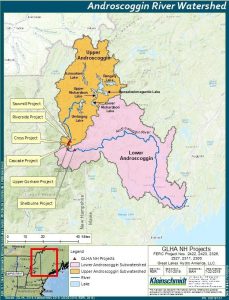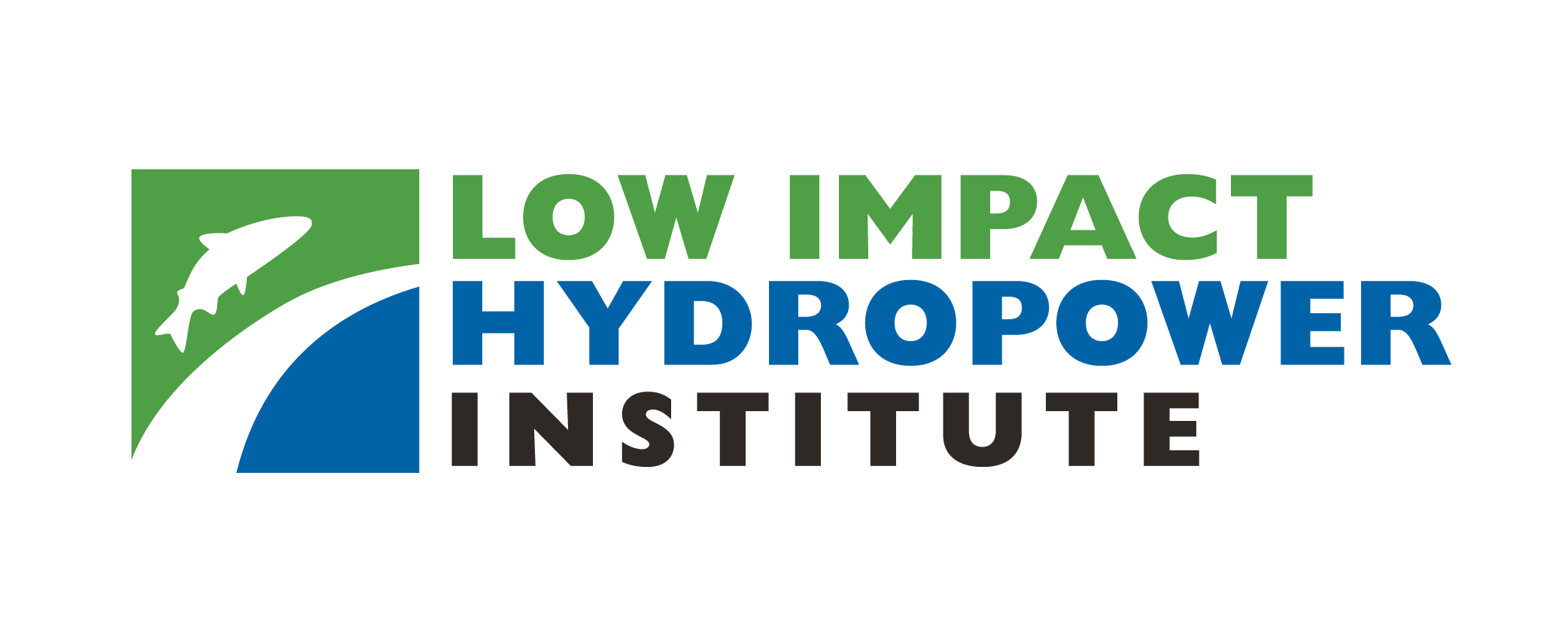LIHI 证书 #174 - 新罕布什尔州 Cross Power 项目



| 项目名称 | 交叉力量 |
| LIHI 证书编号 | 174 |
| LIHI 证书期限 | 2020 年 8 月 31 日 – 2030 年 8 月 30 日 |
| 所有者 | Great Lakes Hydro America, LLC,布鲁克菲尔德可再生能源集团的子公司 |
| 状态 | 新罕布什尔 |
| 地点 | 河流英里 136.9 – 安德罗斯科金河 |
| 装机容量 | 3.22 兆瓦 |
| 平均年发电量 | 15,025 兆瓦时 |
| 设施类型 | 河流径流 |
| 联邦能源管理委员会 不。 | 交叉电源 P-2326
1994 年发行,有效期至 2024 年 7 月 31 日 |
Cross Power 项目位于新罕布什尔州北部库斯县的安德罗斯科金河上。安德罗斯科金河流经新罕布什尔州和缅因州。这条河在缅因州的梅里米廷湾与肯纳贝克河汇合,然后流入缅因湾,随后流入大西洋。安德罗斯科金河流域包含 19 个水电项目,位于这条 178 英里长的河流沿岸。
该项目是柏林和新罕布什尔州谢尔本之间安德罗斯科金河 11 英里范围内的几个水电项目之一,包括上游 锯木厂项目 (LIHI #173) 及下游项目: 卡斯卡特 (LIHI #188), 上戈勒姆 (LIHI #175), 戈勒姆 (LIHI #153), 和 谢尔本 (LIHI #176).
十字架的力量 坝 最初建于 1903 年。它长 566 英尺,最大高度为 20 英尺,由以下部分组成:
- 混凝土非溢流部分与岩架露头相连。其中一个部分包含用于通过累积碎片的挡水板开口。另一个部分位于从露头到 泄洪道.
- 泄洪道长 276 英尺,新设计的泄洪道高 42 英寸 闪光板 将于 2020 年秋季安装。
- 门楼宽 19 英尺,长 124 英尺,有五个隔间。每个隔间内有拦污栅,宽 21.6 英尺,高 18.4 英尺,净间距为 3 英寸。
- 从门楼延伸到河堤的混凝土挡土墙。
这 发电站 位于闸门下游 44 英尺处。发电站为混凝土下部结构,砖砌上部结构,下游岸边有附加结构,内有五台卧式螺旋桨涡轮机,总装机容量为 3.22 兆瓦。
该项目以准径流 模式,并蓄水 22 英亩的水库。蓄水量允许在 6 英寸范围内波动。由于旁路段非常短,发电站基本上是大坝不可分割的一部分,而且由于下游梯级项目的回水,没有规定最低流量释放。流量制度是与美国鱼类和野生动物管理局 (USFWS) 和新罕布什尔州环境服务部协商制定的。
项目范围内的水域被指定为 B 类,适合钓鱼、主要接触娱乐活动和处理后的供水。项目水域被列为受污染水域,因为之前有几家造纸厂排放废水。鉴于该项目采用径流式运营,不太可能对水质产生不利影响。
安德罗斯科金河无法到达 洄游性 项目河段内的鱼类种类。由于下游自然瀑布——刘易斯顿瀑布和朗福德瀑布,该地区没有鲱鱼、蓝背鲱鱼、条纹鲈鱼、七鳃鳗和美洲西鲱等物种。美洲鳗存在于安德罗斯科金河下游,尽管历史上没有一种鳗鱼到达过该河的上游。项目区支持冷水渔业栖息地。新罕布什尔州鱼类和野生动物管理局每年在项目上游放养溪鳟鱼、虹鳟鱼和褐鳟鱼。常驻河流物种包括秋鱼、小嘴鲈鱼、白吸盘鱼、长鼻鲦鱼、普通鲻鱼、斑尾鲻鱼和黄鲈鱼。下游通行可以通过溢洪道流量、低位闸门释放和通过拦污栅的动力进水流量实现。该项目不会妨碍常驻鱼类生命周期的成功完成。
项目用地仅限于项目基础设施占用的区域。该项目的径流式运行和有限的蓄水波动为海岸线地区提供了保护。
项目附近可能存在的受威胁或濒危物种包括北长耳蝙蝠、加拿大猞猁、东部小足蝙蝠、小棕蝠、三色蝙蝠、白头鹰、五月岬莺、晚间蜡嘴雀、锈色黑鹂、林鸫、木龟、美洲貂、游隼和夜鹰。植物种类包括耳状双叶草、山甜欧芹、卵形刺毛莎草、伞形莎草、粉叶草、紫色处女凉亭、圆叶兰花、光滑悬崖蕨、矮蓝莓、香木蕨、心叶双叶草和霍氏柳兰。
列出的蝙蝠物种不太可能受到项目运营的影响,因为通常没有树木清理活动或走廊维护活动。一些植被移除和维护是为了确保大坝安全,但上述活动遵守了美国鱼类和野生动物管理局关于蝙蝠物种栖息地保护的 4(d) 规则。大多数其他列出的物种都在项目附近被发现,但河流运行和蓄水波动限制减轻了对这些物种的影响。
项目区域不支持任何已知的历史或文化资源。但是,该项目在与国家历史保护办公室协商后,根据计划协议 (PA) 进行。PA 提供了详细说明年度监测和报告的规定,这些监测和报告涉及已进行的修复和改进活动以及来年的任何计划活动。
该项目的休闲资源包括尾水垂钓区。免费向公众开放。
合规状态
该证书包括以下针对设施的特定条件:
条件 1: 设施所有者应向 LIHI 提供项目重新许可的持续状态更新,包括研究、FERC 备案、资源机构咨询、处方和建议以及机构对研究结果的评论。LIHI 保留根据重新许可的结果修改证书或条件的权利。
2025: 未发现任何重大变更或合规问题。根据年度审查,该项目仍然合规。对于条件1,该项目提供了状态更新和重新许可文件的链接。联邦能源管理委员会 (FERC) 于 2024 年 10 月 7 日发布了最终环境评估报告,国家水资源与环境部 (NHDES) 于 2024 年 9 月 19 日发布了水质认证。
2024: 未发现任何重大变化或合规问题。根据年度审查,该项目仍然合规。对于条件 1,该项目提供了状态更新和重新许可文件的链接。FERC 于 2024 年 5 月 23 日发布了其环境评估草案。该项目报告了两次水池偏差,而不是 FERC 违规行为。
2023: 未发现任何重大变化或合规问题。根据年度审查,该项目仍然合规。对于条件 1,该项目报告的状态没有变化。
2022: 未发现任何重大变化或合规问题。根据年度审查,该项目仍然合规。对于条件 1,该项目报告称已于 2022 年 8 月 29 日提交最终 FERC 重新许可申请。
2021: 未报告任何变化。该项目报告了由于站点跳闸导致的短暂流量偏差,但这并不构成 FERC 违规行为。根据年度审查,该项目仍然符合规定。对于条件 1,该项目报告提交了重新许可初步研究报告。
2020: 当前证书的年度报告尚未生效。
认证历史
2022 年 1 月 1 日: LIHI 证书期限已根据 2022 年 1 月 1 日发布的 LIHI 第 2 版认证手册 2.05 版延长。有关新期限,请参阅上面的设施表。
2020年11月30日: 2020 年 11 月 27 日上诉期结束后,认证 Cross Power 项目的决定成为最终决定,且无人提出上诉。认证期限为 2020 年 8 月 31 日至 2025 年 8 月 30 日。
2020年10月27日:低影响水电研究所 (LIHI) 初步批准了位于新罕布什尔州安德罗斯科金河上的 Sawmill、Cross Power、Upper Gorham 和 Shelburne 水电项目的低影响认证。该决定是初步决定,需等待 30 天的上诉期。只有在 60 天的评论期内对初始申请发表评论的人才有资格提出上诉。此类上诉需要包括对项目不符合 LIHI 标准的解释。可以通过电子邮件向以下地址提交一个或多个这些项目的上诉请求 comments@lowimpacthydro.org 主题行中请注明“Androscoggin River-NH Projects”,或邮寄至 Low Impact Hydropower Institute,地址为 329 Massachusetts Ave, Suite 6, Lexington, MA 02420。所有申请都将发布在网站上。申请人将有机会作出回应,任何回应也将发布。 请求必须在 2020 年 11 月 27 日东部时间下午 5 点之前收到。完整的申请和审查报告如下。如果没有收到上诉请求,每个项目的认证期限为 2020 年 8 月 31 日至 2025 年 8 月 30 日。
2020 年 8 月 13 日: 低影响水电研究所已收到位于新罕布什尔州安德罗斯科金河上的 Sawmill、Cross Power、Upper Gorham 和 Shelburne 水电项目的完整低影响认证申请。LIHI 正在就此申请征求公众意见。具体来说,我们想知道您是否认为这些项目符合 LIHI 低影响认证标准(第二版手册中修订版)。申请可在下面找到。与特定 LIHI 标准(流量、水质、 鱼道等)将非常有帮助,但所有评论都会被考虑。评论可以通过电子邮件提交给研究所 comments@lowimpacthydro.org 主题行中请注明“安德罗斯科金河-新罕布什尔州项目评论”,或邮寄至低影响水电研究所,地址:329 Massachusetts Avenue, Suite 6, Lexington, MA 02420。 评论必须在 2020 年 10 月 12 日东部时间下午 5 点或之前收到,才会被考虑。 所有评论都将发布到网站上,申请人将有机会作出回应。所有回应也将发布。
